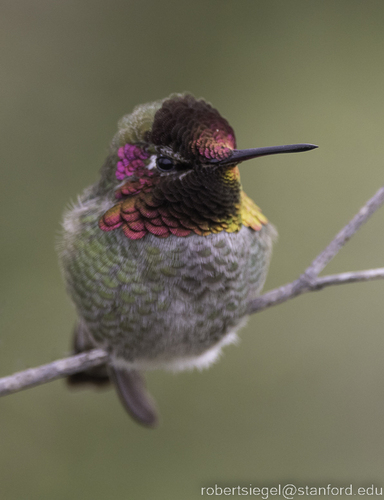
Anna's Hummingbird
Anna's Hummingbird (*Calypte anna*) is a medium-sized hummingbird native to the west coast of North America. It is named after Anna Masséna, Duchess of Rivoli. Uniquely adapted to urban environments, it's a common sight in gardens and parks, known for its iridescent green plumage and the male's striking rose-red gorget (throat) and crown. Ecologically, Anna's Hummingbirds are important pollinators for various flowering plants. Their presence adds a vibrant touch to both wild and urban landscapes, and they are a favorite among birdwatchers.
9-10 cm
Length
11-12 cm
Wingspan
Least Concern
Conservation Status
Distribution
Primarily along the Pacific Coast of North America, ranging from southern British Columbia to northern Baja California, Mexico. Some populations extend inland to Arizona. It is resident year-round in much of its range, with some altitudinal migration in colder areas.
Lifespan
Average lifespan in the wild is about 8 years.
Anna's Hummingbird's Habitat
Habitat Types
Chaparral, Coastal scrub, Oak savannahs, Gardens, Parks, Urban areas
Climate Zones
Temperate, Mediterranean
Adaptations
Anna's Hummingbirds have adapted well to urban environments, utilizing human-provided feeders and ornamental plants. They can enter torpor, a state of reduced metabolic activity, to conserve energy during cold nights.
Variations
No recognized subspecies, but some regional variations in plumage brightness and size have been observed.
Appearance
Breeding Plumage
Males have an iridescent rose-red crown and gorget during breeding season, which can appear duller or even black in low light. Females have a green back and a mostly grayish-white underside, with some red spotting on the throat.
Seasonal Feather Changes
The male's gorget may be more vibrant during the breeding season.
Sex Based Plumage Differences
Significant. Males are easily distinguished by their red crown and gorget, while females are less colorful.
Notable Features
Iridescent green back, Male's rose-red crown and gorget, Long, straight, slender bill, Small size
Diet and Feeding
Primary Foods
Nectar, Small insects, Spiders, Tree sap
Foraging Behavior
Anna's Hummingbirds primarily feed on nectar by hovering at flowers. They also glean insects and spiders from leaves and bark, and occasionally catch insects in mid-air. They are frequent visitors to hummingbird feeders.
Specializations
Their long, slender bill and brush-tipped tongue are specialized for extracting nectar from flowers. High metabolic rate and ability to hover allow efficient nectar feeding.
Seasonal Diet Variations
Insects may form a larger part of the diet during the breeding season when protein demands are higher for egg production and chick growth. Nectar availability varies seasonally depending on flowering patterns.
Behavior
Social Structure
Generally solitary, except during breeding season. Males are highly territorial, especially during breeding.
Communication
Courtship dives, Scratchy songs, Chattering calls, Wing hum
Migration
Mostly resident, but some populations undertake altitudinal migrations, moving to higher elevations in summer and lower elevations in winter.
Territorial or Group Behaviors
Males aggressively defend feeding territories, chasing away other hummingbirds and even large insects like bumblebees.
Conservation
Threats
Habitat loss, Pesticide use, Climate change (affecting flowering times), Collisions with windows
Protection Programs
General wildlife habitat conservation efforts, Promotion of native plant gardening
Local National Laws
Protected under the Migratory Bird Treaty Act in the United States.
Population Trend
Increasing
Population Estimates
Estimated global population of around 6.5 million.
Interesting Facts
They can shake their bodies 55 times per second
This helps them to shed rain or pollen.
Their heart rate can reach up to 1,260 beats per minute
During intense activity, such as hovering flight.
They can enter a state of torpor
To conserve energy, their body temperature can drop significantly, and their heart rate slows dramatically.
They are the only hummingbird species that commonly overwinters in the Pacific Northwest
This is due to their ability to enter torpor and their adaptation to urban environments with supplemental food sources.
Faqs about Anna's Hummingbird
What should I feed Anna's Hummingbirds in a feeder?
A solution of 1 part white sugar to 4 parts water. Do not use honey, red dye, or artificial sweeteners.
How can I attract Anna's Hummingbirds to my garden?
Plant native flowering plants, provide a clean water source, and avoid using pesticides.
Do Anna's Hummingbirds migrate?
While many are year-round residents, some populations exhibit altitudinal migration, moving to different elevations based on the season.
Why is the male Anna's Hummingbird so colorful?
The bright colors are used to attract mates and defend territory from rivals.
How do I clean a hummingbird feeder
Clean with hot water and a bottle brush, and change the sugar solution frequently (every 3-5 days, or more often in hot weather) to prevent mold and fermentation
Copyright @ Nature Style Limited. All Rights Reserved.
 English
English